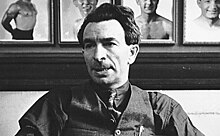Jack Pfefer
| Jack Pfefer | |
|---|---|
 Publicity still of Jack Pfefer. | |
| Born | December 10, 1894 Warsaw, Congress Poland, Russian Empire |
| Died | September 13, 1974 (aged 79) Plymouth, Massachusetts, United States |
| Professional wrestling career | |
| Ring name(s) | Jack Pfefer |
| Debut | c. 1924 |
| Retired | 1967 |
Jack Pfefer (also commonly spelled as "Pfeffer"; December 10, 1894 – September 13, 1974) was an American professional wrestling promoter during the early-to-mid twentieth century. He pioneered an earlier form of sports entertainment, as he was one of the first promoters to visualize the pro wrestling business in the mold of theater. However, he developed an infamous reputation when he exposed the sport's inner secrets to the mainstream press in a spiteful attack that nearly destroyed the entire industry.
Early life
Jacob Pfefer was born near
New York promoter
Upon arriving in the Big Apple, Jack Pfefer quickly aligned himself with renowned New York promoter Jack Curley, who then ranked among the most powerful men in the entire wrestling business. Following the break-up of the famed Gold Dust Trio in the late 1920s, Curley initiated an alliance with several of the East Coast's top bookers, including Toots Mondt and Ray Fabiani; and he subsequently formed an industry “Trust” that enabled the various regions to share their elite grappling talent. Pfefer performed as the group's main talent manager, and he was primarily responsible for scouting potential European grapplers while also overseeing the organization's financial books. Over the next few years, the Trust rode its incredibly popular centerpiece superstar, Jim Londos, to record profits while Pfefer helped lead one of the greatest periods in New York's rich wrestling history. Moreover, as Curley's health began to decline, Pfefer began to position himself among the eventual heirs to the New York wrestling throne.
Exposing the work
In 1932, a contractual dispute caused an eventual rift between Curley and Londos, and the New York territory quickly deteriorated without its top drawing card. Pfefer therefore abandoned Curley in favor of Londos' group in early 1933; but later that November, a peace accord was signed between Curley's East Coast promotion and the Tom Packs/Jim Londos alliance that was dominating in the Midwest. The agreement subsequently extended the Trust's influence throughout all of North America, with Curley, Packs, Mondt, Fabiani, Ed White, and Paul Bowser all agreeing to share the profits evenly. As a result, Jack Pfefer consequently found himself without any allies, as he was stuck on the outside looking in on the industry's powerful new coalition. Ostracized by his fellow wrestling peers, a bitter Pfefer looked to exact revenge, and he therefore arranged an interview with Dan Parker, who was the sports editor for the New York Daily Mirror. Pfefer subsequently took the unprecedented step of revealing most of pro wrestling's secrets and inner workings, freely admitting the sport's "fakery" and theatrics. Although fans had long suspected that pro wrestling was worked, Pfefer had introduced a feeling of cynicism among the mainstream press that they were being used as promotional "chumps" by Curley and his associates; and in a now-famous headline, the November 19, 1934 New York Daily News covered an impending Jim Londos vs. Everett Marshall bout by proclaiming, "Londos and Marshall meet at Garden tonight for 26th time. Score - Londos 26, Marshall 0."
Pfefer again plotted against his former partners when he paid
Later career
Jack Pfefer never retracted his stance that wrestling was more entertainment than competition; and he therefore distinguished himself from his peers by presenting shows as a form of theater, with exaggerated storylines and bizarre performers. He was renowned for his booking of “freak” characters, most notably including the
Personal life
Pfefer was close friends with many of the wrestling personalities he worked with and had a habit of sending gifts to their families. Stu Hart took a great liking to him and asked him to be the godfather of Hart's tenth child and seventh son, Ross Hart.[2]
Accomplishments
- Professional Wrestling Hall of Fame and Museum (Class of 2007)[3]
References
- ^ Ellison, Lillian. First Goddess of the Squared Circle, p.57.
- ISBN 978-1550227413.
- ^ "The Professional Wrestling Hall of Fame and Museum". wrestling-titles.com. Retrieved 2016-02-25.
Further reading
- Ellison, Lillian (2003). The Fabulous Moolah: First Goddess of the Squared Circle. ReaganBooks. ISBN 978-0-06-001258-8.
